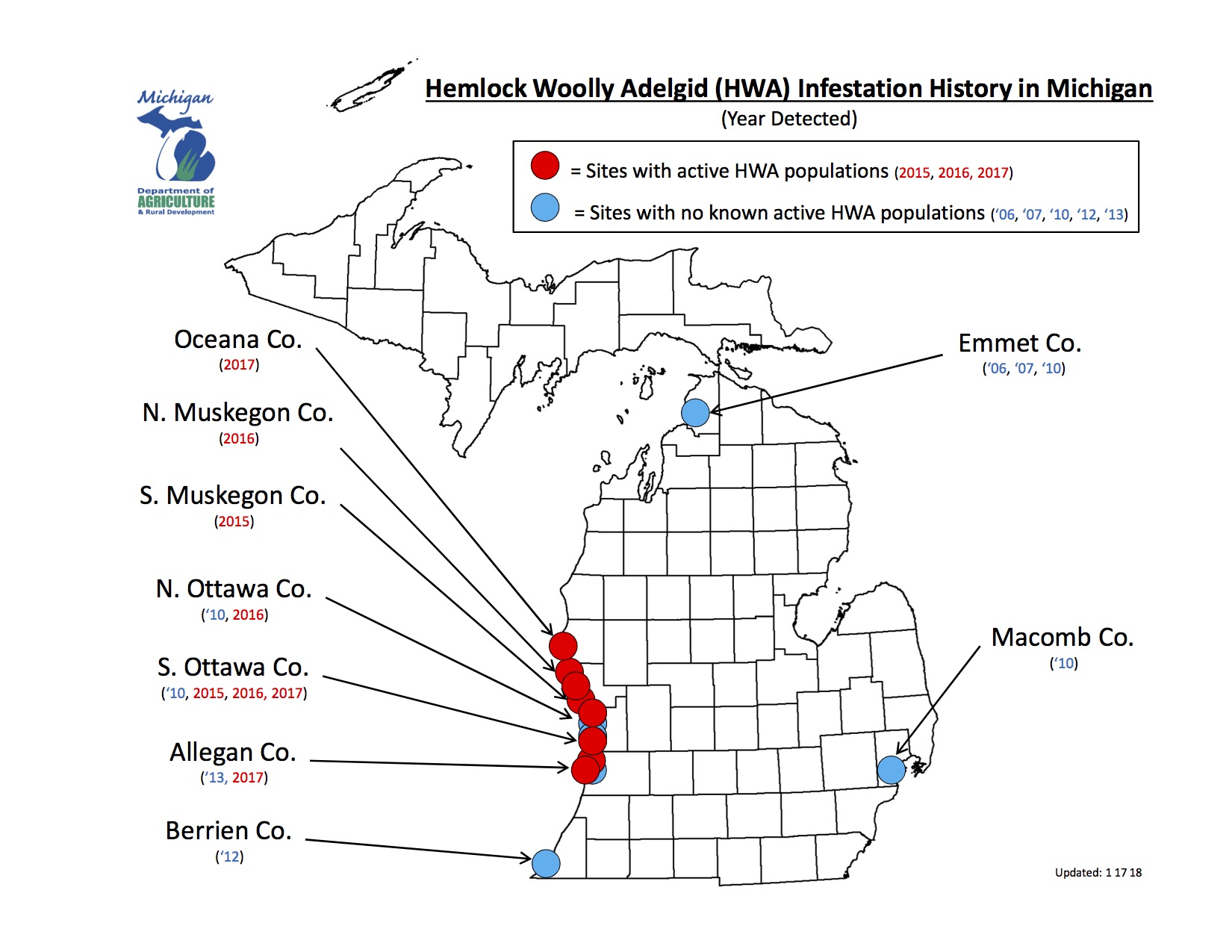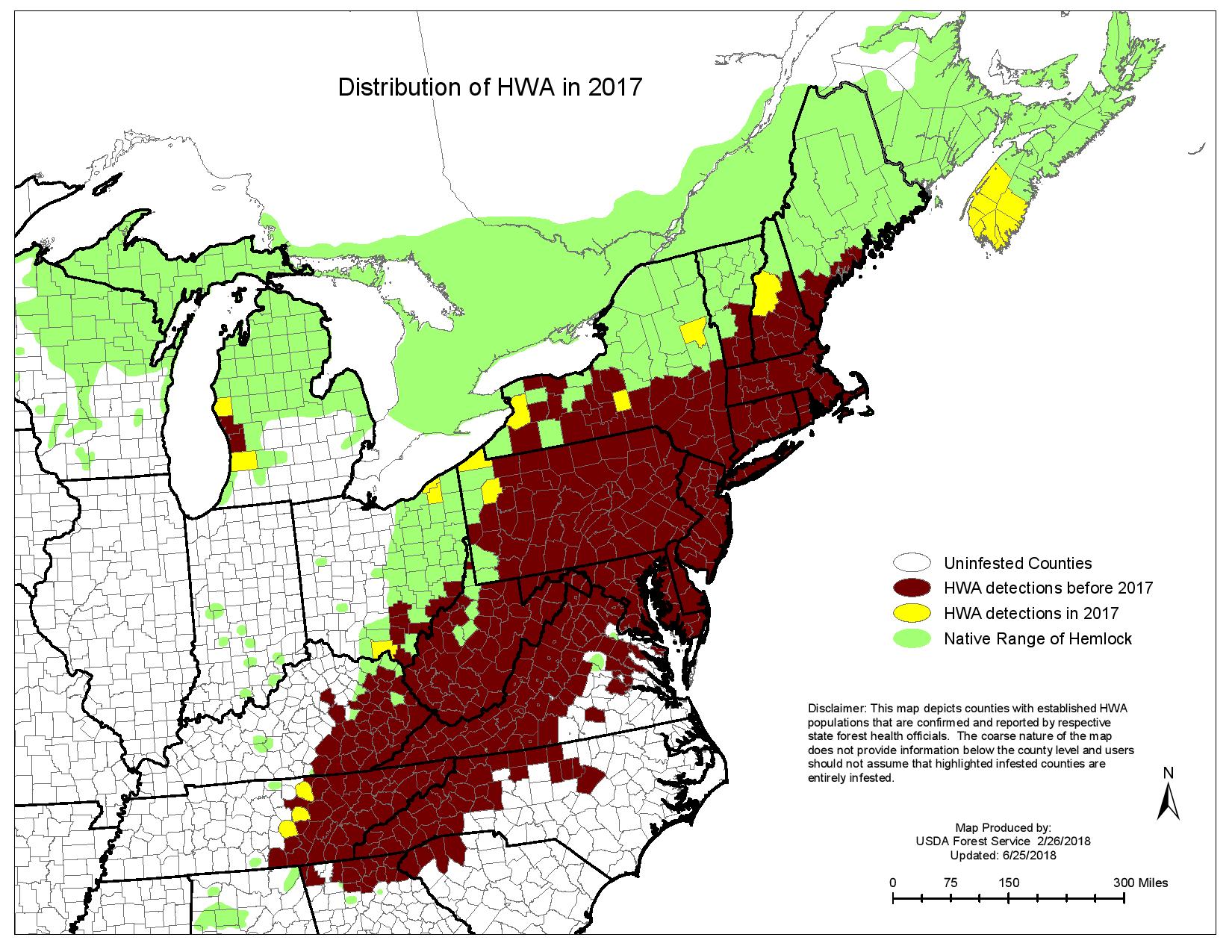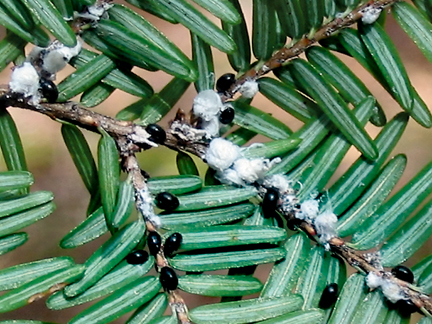Hemlock Woolly Adelgid (HWA) Control for Michigan and the Upper Northeast
Most southern hemlock areas of the eastern US have already been “buried” under an avalanche of Hemlock Woolly Adelgid (HWA), generated by exponential growth from multiple horticultural HWA introductions in the early 20th century. But there are extensive hemlock areas in Michigan and the upper Midwest that face a threat from recent HWA introductions, while some northern areas of Vermont, New Hampshire, Maine, & upstate New York are just beginning to experience the HWA influx (due to the colder winter temperatures that have slowed HWA movement). And these areas are the targets for the early intervention strategy proposed here.
Until recently, the upper Northeast has been protected from Hemlock Woolly Adelgid by extreme winter temperatures while Michigan has been protected by geographic separation from HWA introduction areas further east. But now these areas with newly or soon-to-be HWA-infested hemlocks have a special opportunity (and need) to initiate biological control intervention strategies in order to prevent or limit Hemlock Woolly Adelgid damage to native hemlock populations. Below is the latest (2017) USDA Map documenting HWA Infestations in the eastern US.
Michigan is of special interest as the “gateway” to the northern hemlock forests, of upper Michigan, Wisconsin and Minnesota, that have not yet experienced HWA infestation. Below is a 2018 map for the known Hemlock Woolly Adelgid distribution in Michigan. Note that several early HWA infestation sites (marked in blue) have apparently been eradicated by chemical treatments. But there are also multiple recent active HWA sites (2015-17) (marked in red) that span about 80 miles of Lake Michigan coastline. Does this look like successful eradication to you? While I have no site information beyond the MDARD map, I think that interpreting HWA in Michigan as “under eradication” (or even under containment) is fanciful, at best.
Remember that sites marked here are those with known Hemlock Woolly Adelgid distributions. How many hemlock sites are there over this stretch of, say, 800 square miles (80 x 10)? – not to mention sites further to the north and east? And how many of those hemlock sites have unrecognized populations of HWA present? (MDARD estimates that there are over 170 million hemlocks in Michigan). Chemical control can only hope to “eradicate” HWA when the Hemlock Woolly Adelgid are contained to limited physical areas in which all existing HWA-infested hemlocks are known and can be chemically treated. And that does not appear to be the case here!
Early Intervention and Control of Hemlock Woolly Adelgid
The hopeful news is that an early Hemlock Woolly Adelgid infestation offers a good opportunity to apply an Integrated Pest Management approach, using both chemical and biological strategies to control HWA. This would involve applying chemical treatments to a small number of larger hemlocks – to protect these trees from immediate damage, while releasing predator beetles on untreated hemlocks – to establish a predator population capable of long-term biological control of hemlock woolly adelgid populations – across all hemlocks. And this IPM strategy would have both fiscal and environmental benefits, by reducing the use of neonicotinoid insecticides and providing long-term HWA control.
Such “early intervention efforts” can draw on over 20 years of USDA-funded scientific research and knowledge about the multiple strains of hemlock woolly adelgid and HWA origins, predators, and ecology. For example, we know that our”imported” HWA (in the eastern US) originated in Southern Japan, where it co-exists with both the native Southern Japanese Hemlock (Tsuga seiboldii) and imported hemlocks (Tsuga canadensis) from the eastern US. And the key to this healthy hemlock/HWA coexistence in Japan is the activity of a “specialized predator” beetle (Sasajiscymnus tsugae) that feeds only on HWA and other adelgids. (This USDA/APHIS-approved, adelgid specialist predator has been determined to not represent a threat to other native insects or plants in the eastern US).
But not all HWA predator beetles are equally effective. Specifically, the Laricobius HWA predator beetles (L. nigrinus & L. osakensis) that are sometimes recommended for release in the Northeast, can only feed on the first of the two consecutive HWA reproductive cycles. And recent USDA research reports that such limited first cycle HWA predation by Laricobius will be “overwhelmed” by the second HWA reproductive cycle. As a result, Laricobius releases should only be considered as a supplement to the USDA-approved, summer feeding HWA predator – Sasajiscymnus tsugae (St) which feeds on both HWA reproductive cycles. USDA-funded research suggests that St biological control interventions are capable of extending protection to hemlock areas and entire hemlock ecosystems. And this is the only approved HWA predator that is stand-alone effective and readily available to all property owners, both private and public (beetle source) .
A Pre-Infestation Intervention Strategy
It may even be possible to establish a predator population to control Hemlock Woolly Adelgid before HWA arrives in a hemlock forest area! This early intervention strategy involves using a native woolly adelgid as a food source to “grow” and establish the predator beetle population. This will create a “predator welcome commitee” to greet advancing HWA arrivals! And this in turn should minimize HWA damage to hemlocks in these early infestation areas.
The prime adelgid food candidate for such an early intervention strategy is the Pine Bark Adelgid (Pineus strobi) which is present on most White Pines (Pinus strobus) in the eastern US and which reproduces May through September. White Pines should be present in most of the hemlock areas that will experience an HWA influx in the next decade (in Michigan, Vermont, New Hampshire, Maine, & Upstate New York). But the less widely distributed Balsam Spruce, with their imported Balsam Woolly Adelgid (Picea adelges), will also support Sasajiscymnus tsugae feeding and reproduction for early intervention releases.
Below are additional information sources that you can use in planning a biocontrol intervention to protect our native hemlocks from Hemlock Woolly Adelgid damage:
Planning and Implementing Predator Beetle Releases
Commercial Source for HWA predator beetles
History of HWA Introduction to Eastern North America


